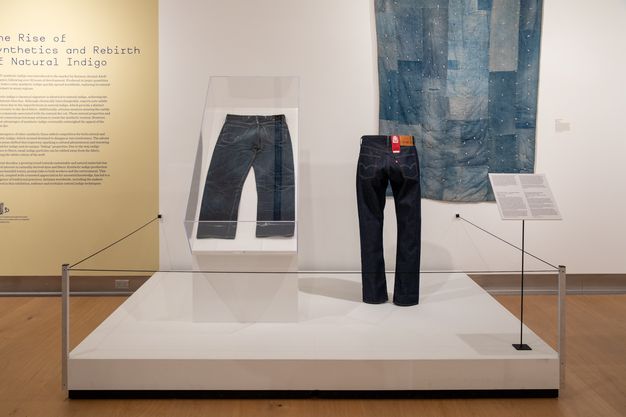Blue jeans are central to the conversation about contemporary uses of indigo. As a fashion phenomenon, jeans revitalized the demand for the dye, which had competition from other synthetic blues. Miners and other workers in the American West needed durable pants, prompting tailor Jacob Davis to partner with Levi Strauss & Co. on a U.S. patent in 1873 for riveted waist overalls. Denim, a traditional workwear cloth, became the fabric of choice since it was tough-wearing and hid stains and dirt. Initially dyed with natural indigo, denim’s distinctive fading patterns reflected the wearer’s habits, showing where the pants saw the most wear, even indicating what they carried in the pockets.
In the early 20th century, Levi Strauss & Co. switched to synthetic indigo, chemically identical to natural indigo. Jeans were primarily workwear for miners, farmers, cowboys, railroad workers, and service members. After World War II, jeans transitioned from functional attire to an identity icon. Returning servicemen formed motorcycle clubs, all wearing blue jeans. In the 1950s, jeans became synonymous with rockabilly and, in subsequent decades, symbolized various countercultures, from rockers and hippies to grunge and skateboarders—ultimately becoming mainstream.
Many brands influenced the denim and fashion industry—perhaps none as recognizable as Levi’s, with its iconic red tag—playing a significant role in maintaining the popularity of indigo today.

left in gallery photo
Levi’s® 501® Jean — Arizona Cowboy
Collection of Levi Strauss & Co. Archives
Levi’s® jeans reveal much about their history and wearers. This pair was made on a shuttle loom, evident from the woven selvage edge along the seam, slub (uneven thickness) in the yarns, and loom chatter (imperfections) in the weave. Several features indicate they were made after 1900: the rich blue of synthetic indigo called “red cast denim” because of its red/purple tint (unlike the greener tinted natural indigo); two back pockets, the second pocket was introduced in 1901; and the post-1890 rivet imprint, which changed after the patent expired. They were constructed in the early 1930s as evidenced by the absence of a red tab on the right back pocket. The company did not introduce the red tab until 1936. During World War II, the company removed the back buckle and rivets on the tiny watch pocket and crotch to conserve materials.
The jeans’ wear patterns provide clues about their owner. The saddle and spidering marks suggest long hours in the saddle, indicating the wearer was likely a cowboy. Cuff marks on the legs hint at pre-shrunk fabric, with cowboys cuffing jeans to manage length and use as extra storage. These details help historians deduce the wearer’s activities and the jeans’ era.
right
Pre-Production Pair of Levi’s®
Plant-Based 501® Jeans
Levi Strauss & Co. – Designed by Una Murphy and Paul
Dillinger
2023
United States of America
Denim
Courtesy of Levi Strauss & Co.
The Plant-Based 501® was launched in 2023 to celebrate the 150th anniversary of the Levi’s 501® Jean. It was made with 100% certified organic cotton denim, a plant-based patch (plastic-free alternative to leather), ink made from wood waste, and 100% plant-derived indigo dye from Stony Creek Colors, a natural dye grower based in Tennessee.
These jeans represent a multi-year research-through-practice collaboration between Levi’s and Stony Creek Colors—exploring new pathways to reintroduce plant-based indigo dye to the commercial denim market.
These jeans are an evolution in the company’s innovation
practice—learning from each season to refine our approach
to sustainable design and establishing new foundations for
the future of Levi’s product creation. They are an
indication of what the industry could look like in the
years ahead, given the push to minimize synthetic
materials derived from fossil fuels and the need to make
more garments with renewable inputs rather than finite
resources.
Courtesy of Levi Strauss & Co.